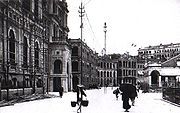Portal:British Empire/Selected article/4

In the 19th century the British, Dutch, French, Indians and Americans saw Imperial China as the world's largest untapped market. In 1840 the British Empire launched their first and one of the most aggressive expeditionary forces to claim the territory that would later be known as Hong Kong. In a few decades, Hong Kong was transformed from rocky undeveloped mountainous terrain to a major entrepot for global trade. By means of the First and Second Opium Wars and the resultant series of treaties, the British were able to legitimately claim the territory until 1997. Early social and economic problems existed in the colony, as there were drastic differences between Eastern and Western philosophy and culture. Nonetheless, Hong Kong seized the opportunity to become one of the first parts of East Asia to industrialise and modernise.
One observer summed up the decades as "politics, propaganda, panic, rumour, riot, revolution and refugees". The role of Hong Kong as a political safe haven for Chinese political refugees further cemented its status, and few serious attempts to revert its ownership were launched in the early 20th century. Both Chinese Communist and Nationalist agitators found refuge in the territory, when they did not actively participate in the turmoil in China. However, the dockworkers strikes in the 1920s and 1930s were widely attributed to the Communists by the authorities, and caused a backlash against them. A strike in 1920 was ended with a wage increase of HKD 32 cents.
When modern China began after the fall of the last dynasty, one of the first political statements made in Hong Kong was the immediate change from long queue hairstyles to short haircuts. In 1938, Guangzhou fell to the hands of the Japanese, Hong Kong was considered a strategic military outpost for all trades in the far east. Though Winston Churchill assured that Hong Kong was an "impregnable fortress", it was taken as a reality check response since the British Army actually stretched too thin to battle on two fronts.
